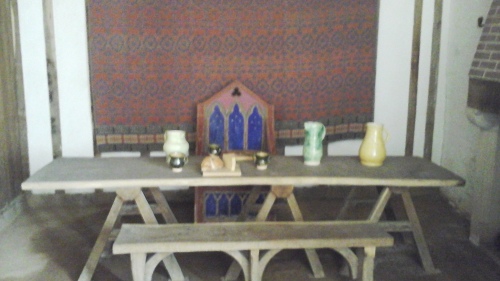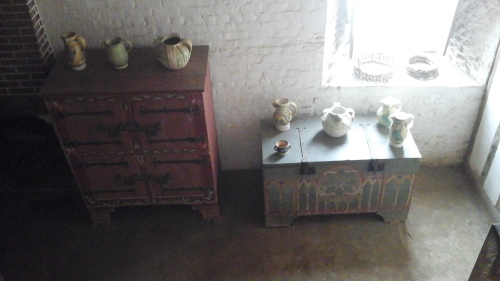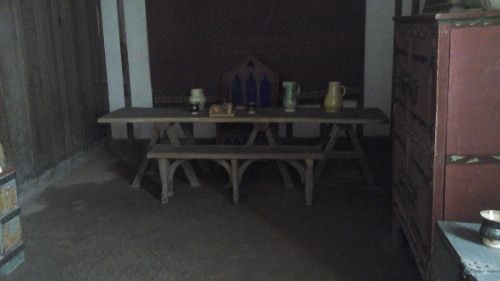
The hall of the Medieval Merchant’s House, Southampton
Last week I gave an overview of the Medieval Merchant’s House in Southampton. This week we’ll spend some time in the most important space in the house – the hall.
Even though the house was owned by a wealthy merchant, the hall is quite small. The table takes up almost the entire width of the room. As indicated by the objects on the table, this was where the merchant, his family and their visitors would have eaten. They would have sat on one side of the table only and another table would have been put along the wall at right angles to the high table to accommodate any else who was eating with them.
The house has been furnished in fourteenth-century style based on furniture that has survived from that period as well as illustrations from the fourteenth century. The pottery jugs and pots are copies of vessels found during excavations in a nearby street.
The hall would have displayed the merchant’s wealth, which you can see represented above by the ‘tapestry’ and below by the jugs and pots standing on the cupboard and the chest at the foot of the stairs leading up to the first floor.

Ceramic displays in the hall of the Medieval Merchant’s House, Southampton
The window you can see above, like the rest of the windows in the house, did not originally contain glass. They were closed with shutters.
The man who lived in such a house would have been wealthy enough to have silver vessels. silk, lengths of fine cloth, carpets, feather-beds, chests and expensive, fashionable clothes. All of these were mentioned in a merchant’s will in the middle of the fourteenth century. As much as possible of the merchant’s wealth would have been displayed in the hall.
Another chest stands against the wooden partition separating the hall from the passage.

Chest in the hall of the Medieval Merchant’s House, Southampton
The hall was open to the ceiling. There would have been a kind of chimney in the roof, since there would have been an open fire on the floor. In the photograph below you can see the gallery which runs between the two first floor bedrooms.

Wall and ceiling of the hall, the Medieval Merchant’s House, Southampton.
This fire was the only form of heating in the house when it was first built. The windows were unglazed and the house would have been cold most of the time. In the winter it would have been very cold.
The floor is made of earth. It would have been covered in rushes. This is not a sign of poverty. The floor of most dwellings would have been made of earth, then covered with rushes. Tiles and stone were only for the very wealthy and cathedrals.

Earthen floor, Medieval Merchant’s House, Southampton
I have included the picture below, despite its quality, to show how small the hall is. I took it from the bottom of the stairs, with my back against the far wall.

Length of the hall, Medieval Merchant’s House, Southampton



Thanks for the tour and the wonderful information. I never know what I’m going to learn here, but it’s always interesting.
LikeLiked by 1 person
Thank you, Dan.
LikeLiked by 1 person
This is awesome, April! The pictures, with your descriptions, really give a sense of the place. I’m also appreciating my insulated windows a bit more at the moment – can’t imagine how cold it must have been most of the time!
LikeLiked by 1 person
Thank you. Yes, it would have been very cold in the winter. I doubt if anyone would have moved very far from the fire in the hall.
LikeLiked by 1 person
Fascinating stuff! Have subscribed x
LikeLiked by 1 person
Thank you. I’m glad you enjoyed it.
LikeLike
Pingback: Medieval Merchant’s House – The Back Room | A Writer's Perspective
Pingback: The Medieval Merchant’s House | A Writer's Perspective
Pingback: The Hall of a Medieval Manor House | A Writer's Perspective